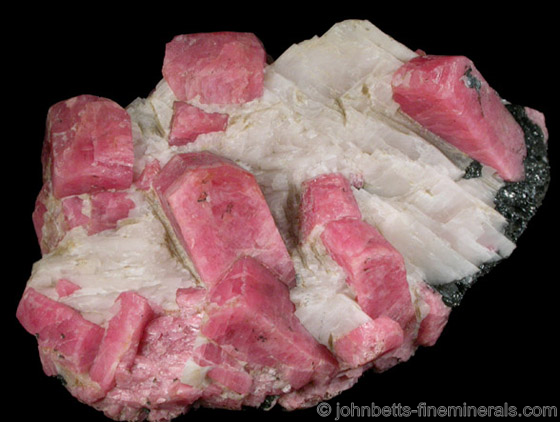The Mineral rhodonite

Rhodonite is well known among collectors for its beautiful pink and red color. The red variety can be so deep red that it rivals the color of Ruby. The large crystals once found in Franklin, New Jersey, are classic rarities that make magnificent reference pieces.
Rhodonite often has black manganese oxide veins running through a specimen, giving it the distinct appearance of pink with black crisscrossing lines and flower-like formations throughout. These are the forms most commonly used as gemstones, especially in beads and ornamental objects. Large massive specimens of black-streaked Rhodonite is often sliced and polished into slabs for collectors.
For additional information, see the gemstone section on Rhodonite.
Color
Red, pink, orange-red, and brownish-red. Massive specimens often have black veins running through them. Some Rhodonite specimens tarnish black or brown upon exposure to air.
Properties
Streak
Colorless |
Hardness
5.5 - 6 |
Transparency
Transparent to translucent |
Specific Gravity
3.4 - 3.7 |
Luster
Vitreous |
Cleavage
2,2 - forming at an angle near 90º |
Fracture
Hackly, uneven |
Tenacity
Brittle |
Additional Information
Composition
Manganese silicate, sometimes with some calcium, iron, and magnesium |
In Group
Silicates; Inosilicates |
Striking Features
Color, crystal habits, and localities |
Environment
Manganese-rich metamorphic environments and hydrothermal replacement deposits.
|
Rock Type
Metamorphic |
Varieties
-
Bustamite is often regarded as a calcium-rich variety of Rhodonite, but it is scientifically classified as an individual separate mineral species.
-
Rhodonite from the Harstigen Mine in Pajsbergat, Sweden.
Uses
Rhodonite is a popular mineral among collectors. When it forms in large crystals or with a deep red color it is extremely sought after by collectors and can command very high prices. Rhodonite is also a minor gemstone, being cut and polished into cabochons, beads, and other ornamental objects. Rhodonite is also a minor ore of the element manganese in manganese deposits.
Noteworthy Localities
The two most outstanding localities for this mineral, where incredible blood-red transparent crystals came from, are Broken Hill, New South Wales, Australia; and Morro da Mina in Conselheiro Lafaiete, Minas Gerais, Brazil. Two Peruvian localities in Ancash Department (formerly Huanco) that produced fabulously-colored Rhodonite are the Chiurucu Mine in Dos de Mayo Province, and the San Martin Mine in Huallanca.
Some of the largest and most classic Rhodonite crystals once came from Franklin, Sussex Co., New Jersey. Rough masses can still be found there in the Buckwheat Dump, but
the fine crystals are long exhausted.
The Sterling Hill Mine in nearby Odgensburg also produced some Rhodonite crystals, but not quite as magnificent as those at Franklin.
Pink crystals similar to those at Franklin are well known from the Harstigen Mine in Pajsbergat, Varmland, Sweden. A classic source of Rhodonite was Malosedel'nikovskoe, Yekaterinbug, in the Ural Mountains of Russia, where massive Rhodonite was mined for its use as an ornamental stone, especially for use in the palaces of the Czars. Two notable Italian occurrences are the Val Graveglia Mine, Reppia; and Civillina Mt., Recoaro Terme. A massive pink Rhodonite comes from Tamworth, New South Wales, Australia.
Other U.S. localities are the Betts Manganese Mine, Plainfield (near Cummington), Hampshire Co., Massachusetts; Cumberland Hill, Providence Co., Rhode Island; and Jail Hill, Haddam, Middlesex Co., Connecticut.
Distingushing Similar Minerals
Rhodochrosite - Softer (3½ - 4), lacks black veins.
Pyroxmangite - Indistinguishable without complex tests.
Bustamite - Lighter pink color.
Pink Feldspar - Lacks black veins, color not as intense.